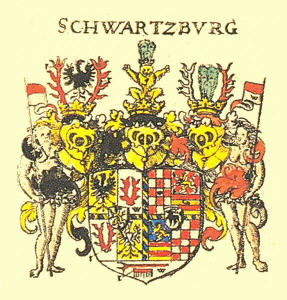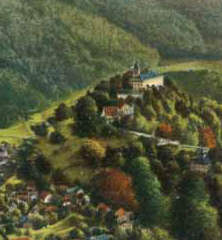 - Schwarzburg
- Schwarzburg
The house of Schwarzburg was one of the oldest and noblest in Thuringia. Tradition traces its descent from Widukind and the kings of the Franks. Its historical ancestors were the counts of Kaefernburg, who were fiefs of the Abbey of Hersfeld. By 1184 the family held Kaefernburg, Schwarzburg, Blankenburg and Konigsee and later acquired Sondershausen, Rudolstadt and Frankenhausen.
The name Guenther became the distinctive name for the members of this house. Various subdivisions and collateral lines were formed, including Schwarzburg-Arnstadt and Schwarzburg-Blankenburg. Between 1231 and 1357 the Schwarzburg-Blankenburg line held the Greifenstein castle near Bad Blankenburg. Günther von Schwarzburg (1304 - 1349) was the younger son of Henry VII count of Blankenburg. Günther distinguished himself as a soldier and in 1347 he was elected Emperor in Frankfurt, after Edward III of England had declined. By 1599 all were extinct except Schwarzburg-Sondershausen and Schwarzburg-Rudolstadt. Count Guenther XL, who died in 1552, was the last common ancestor of both lines.
The possessions of the house of Schwarzburg consisted of the upper barony in Thuringia, on the Gera, Ilm and Saale, and the lower barony on the Wipper and Helbe.
- Schwarzburg, Blankenburg, Leutenberg, Gehren, Ehrenstein were immediate fiefs of the Empire
- Rudolstadt and Könitz were fiefs of Bohemia
- Sondershausen and Straussberg were fiefs of the elector of Mainz
- Frankenhausen, half of Heringen, Kelbra, Greussen, Klingen were fiefs of the elector of Saxony
- Arnstadt, Käfernburg, Plauen, Ilm were fiefs of Saxe-Weimar
- Allberberg was fief of Hesse-Cassel
- Allmenhaussen was fief of the abbey of Fulda.
 The Schwarzburg arms of 1605 show in the right half a quartered shield with in 1 and 4 the eagle of Sondershausen and in 2 and 3 the deer antler of the Lordship Arnstadt. The escutcheon shows the lion of Schwarzburg. The left half also shows a quartered shield, with 1 and 4 the chequered field of the county Hohenstein, and in 2 and 3 the lion and bars for the county Lutterberg. The escutcheon shows the deer of the Lordship Klettenberg.
On the quartering is a cross, which symbolises the medieval title of Viergraf. The base of the shield finally symbolises the title of Imperial Stable Master held by the Princes.
The Schwarzburg arms of 1605 show in the right half a quartered shield with in 1 and 4 the eagle of Sondershausen and in 2 and 3 the deer antler of the Lordship Arnstadt. The escutcheon shows the lion of Schwarzburg. The left half also shows a quartered shield, with 1 and 4 the chequered field of the county Hohenstein, and in 2 and 3 the lion and bars for the county Lutterberg. The escutcheon shows the deer of the Lordship Klettenberg.
On the quartering is a cross, which symbolises the medieval title of Viergraf. The base of the shield finally symbolises the title of Imperial Stable Master held by the Princes.
Both Schwarzburg-Sondershausen and Schwarzburg-Rudolstadt were raised to the dignity of imperial prince and in 1713 a treaty of mutual succession was made between the two families. In 1807 both entered the Confederation of the Rhine and became sovereign states. Both states entered the German League and were principalities and independent members of the German empire until 1918.
Princess Anne Sophia of Schwarzburg-Rudolstadt married Franz Josias of Saxe Coburg Saalfeld. Their descendants include both Queen Victoria and her husband, Prince Albert.
Arnstadt
Arnstadt is the oldest documented town of Thuringia, first mentioned as Arnestati in a document of AD 704. In 726 Arnstadt came in possession of the monastery of Echternach in Luxembourg and later passed to the abbey of Hersfeld. The eagle appears on the coins of the Hersfeld Abbey, struck in Arnstadt in 1200.
In 925 the Counts of Käfernburg founded a monastery, which was first mentioned in 1196. The election of Philipp of Swabia as German King took place in Arnstadt in 1198. The first mention of Arnstadt as a 'civitas', a town, dates from 1220. The formal rights of a town were granted in 1266. In 1290 one part of Arnstadt came in possession of the counts of Käfernburg, while the other part remained with the abbey of Hersfeld. After the line of the counts of Käfernburg became extinct in 1302, their part of Arnstadt in 1306 passed to the counts of Schwarzburg, who lived there until 1716 (The remaining, larger, part of Arnstadt was bought in 1332) Their palace, Monplaisir (1703-07), survives, and the 12th-14th-century Church of Our Lady (Liebfrauenkirche) has a number of Schwarzburg graves.
site map - info@friedrichfroebel.com
Copyright © 2002-13 friedrichfroebel.com. All rights reserved.
